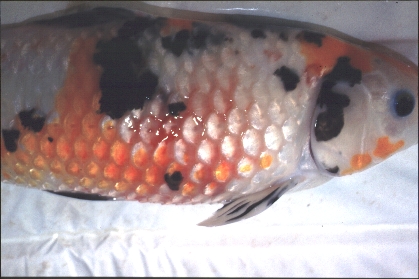Koi suffer can suffer from a whole range of health problems and diseases including hypoxia, gas bubble disease, dropsy and general lumps and bumps.
Dropsy
In the case of ‘dropsy’ or ‘pine-cone disease’ the fish’s body often swells up, the eyes may start to bulge out (exophthalmia) and some or all of the scales may stand out from the body, giving the appearance of a pine-cone, hence the common name. This is an extremely serious condition having many possible causes. It is important to understand that it is merely a clinical description of the condition: there is no actual disease called ‘dropsy’. Dropsy could indicate a contagious infection so it makes sense to isolate any affected fish.

Raised scales all over the body suggest the fish is taking on excess water: Dropsy
A long-term bath of salt at one-ounce per gallon may help reduce osmotic stress and in general I would recommend a course of antibiotics in case the problem is bacterial. It is reasonable to assume that the condition is stressful to fish and, unless there are signs of improvement, it may be kinder to euthanase the fish, rather than prolong its suffering.
Hypoxia
Hypoxia is ‘oxygen starvation’. Most koi ponds are usually well served with venturi retums or waterfalls, but poor pond maintenance, high stocking levels and unusual climatic conditions can lead to low dissolved oxygen (DO) levels. Low DO is likely to occur in summer. As water becomes warmer it can progressively hold less oxygen: and the fish become more active, leading to a greater demand for oxygen; and the bacteria in the pond and filters need more to, as do submerged green plants including algae.
The role of submerged plants and algae should perhaps be clarified. During photosynthesis, submerged plants release oxygen into the water, which is why they are often called oxygenating plants. However, they also respire at the same time, extracting oxygen from the water and excreting carbon dioxide. During daytime they produce more oxygen than they consume, but at night, when photosynthesis ceases, respiration continues and they become net oxygen consumers.
Clearly, if the oxygen demand exceeds the oxygen supply then the DO levels will gradually decline and this presents a serious danger to the koi. Common causes of low DO, apart from high fish densities, are heavy feeding and a dirty pond or filter.
A lot of oxygen can be used in oxidising organic waste and, under certain conditions, this extra demand may be ‘the straw that breaks the camel’s back’.
Unfortunately, a DO problem often occurs in the early hours of the morning. when we are not there to see its direct effects on the fish, rather than during the day when submerged plants are releasing oxygen from photosynthesis.
Typical clinical signs of low DO are lethargy and a tendency for the fish to gasp at the water surface and congregate around water returns. Many of these signs are the same as for a gill problem so a test for DO has to be made to be conclusive. There are cheap DO test-kits available but it is important to follow the instructions carefully to avoid introducing oxygen into the water sample by agitation or by pouring water into the test phial. If low DO is the problem, i.e. DO is less than 5 to 6 ppm (mg/litre), then additional aeration will help – but it is essential to determine what caused the problem and to take remedial action.
‘Gas bubble’ disease
‘Gas-bubble’ disease (which is uncommon) presents the opposite problem to hypoxia. It is caused by over-saturation of the water with air. During summer it is tempting to try and force as much oxygen as possible into the water but it is important to realise that at any given temperature there is a maximum amount of oxygen the water can naturally hold If this level is exceeded for example by forcing air into the water under pressure the water can become supersaturated with oxygen.
Given my earlier comments about the dangers of hypoxia, this may seem a desirable state of affairs but it isn’t. If excess air is forced into water it will gradually come out of solution as the natural equilibrium is restored. This excess air may come out of solution in the fish’s bloodstream.
Typical signs of which are visible air bubbles in the eyes, gills and sometimes in the skin. This problem can be detected by measuring total dissolved gases (DO, nitrogen, argon, dissolved carbon dioxide etc.) though the equipment required is expensive.
Lumps and bumps
Koi are often seen with swellings and growths. The causes and conditions can be complex and I am in danger of making oversimplified comments on what is a specialist area of fish health. It is worth trying to make a few generalizations but, if your fish are affected, seek expert opinion.
If a fish has any unusual lumps try to determine whether they appear either over or under the skin. Often it is easy to decide but there are some skin conditions which result in very large tumours, where there tends to be very little distortion of the surrounding, unaffected, tissues. Deep-seated (below the skin) lumps tend to distort and distend a larger area of seemingly healthy tissue.
Where a deep-seated lump or growth is suspected, there are several possible causes; for example, an internal tumour or the onset of a bacterial problem. In this case expert opinion should be sought, as any delay could be serious.
Most skin growths, while disfiguring, are rarely fatal. These can be small milky white-to-grey growths that resemble drops of candle-wax, typical of carp pox. Such growths are often seen on the fins, especially during early spring. At the other extreme, some skin tumours can grow to the size of tennis-balls and range in colour from white to pinky-red. While they can be benign, expert opinion is advisable, especially if the growth interferes with normal swimming and feeding.
In general, there is little that can be done about growths, as many are caused by viruses or other unknown factors. It is possible to attempt surgical removal of larger growths, but this is not usually advisable unless there is a compelling reason to do so. With any type of growth, there is always the risk of secondary bacterial infection so the condition needs to be monitored closely. Often, the problem tends to resolve itself, though it may take a while and, as with any viral problem, there is a strong possibility of a recurrence.

